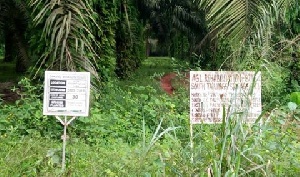Mining activities are safe if the right processes of ensuring safe environmental practices are adhered to by the individual, illegal miners, small scale miners as well as the big mining firms.
Conservation of environment is important to the health of the individual, in recent times, there have been talks, write-ups, radio discussions, workshops, training and massive crusade on the need to eradicate illegal mining (galamsey) in the country.
Illegal mining activities have polluted many water bodies, destroyed farm lands, degraded the environment, caused the death of people involved in it among others –mining pits are opened without being covered and even some small-scale miners who say they are involved in responsible mining are found wanting in ensuring safe environmental practices.
Not every place in the country is mineable, but if you are qualified to be given a license to mine, should you, as an individual, group or company open mine pits and not cover it when the mine is over?
Rehabilitating the land when the activities of a mine is over should be the responsibility of all and authorities such as the Minerals Commission, Environmental Protection Agency (EPA) among others should ensure that the right processes are followed for a healthy environment.
One may ask; after mining, what should the land be used for? Mostly, before mining, land used by these big mining companies are being occupied by indigenes of a particular community for farming.
If a company decides to prospect in such areas, then, these farmers are compensated depending on the hectares of land used in their farming activities and are relocated.
Relocation deprive such farmers their livelihood, in order to sustain them, some mining companies develop the people in terms of acquiring skills in auto mechanics, engineering, batik, tie and dye making organic horticulture production among others.
What do these communities benefit from when there is a closure of a mine? Some mining companies introduce sustainable livelihood programmes such as cultivation of crops and when the land is reclaimed.
Closure of a mine means the decommissioning of site facilities and the rehabilitation of disturbed lands such that the regulatory requirements are met and that the long-term liabilities are reduced to levels accepted by stakeholders.
Rehabilitation, is also a process of restoring any disturbed or damaged lands such as mine pits, roads, tailing areas, rock storage areas, mineralized waste among others towards a defined beneficial land use.
A visit to Abosso Gold Fields Limited –Damang Mine in the Prestea-Huni Valley District in the Western Region to see the procedure for rehabilitation and closure shows that it is not as easy job.
According John Adingelah, Acting Health, Safety and Environment (HSE) Manger of the Abosso GoldFields Limited (AGL), restoring the land to its original state take years.
He explained that all parties interested in and affected by the operations of AGL such as shareholders, local residents, non-governmental organizations, workers and regulatory agencies are brought on board for discussions.
He said the HSE department ensures that the rehabilitation needs are incorporated into mine plans in relations to rehabilitation earth works and closure scenarios for ensuring that equipment and resources are available to fulfill the rehabilitation programme.
“There is a rehabilitation and closure plan that provides supported estimate of the cost that will be needed to reclaim disturbed lands and to decommission infrastructure such as roads, buildings, plant, drainage works among others” he said.
Also, he said there is stakeholder meeting in the form of Damang Mine Community Consultative Committee (DMCCC) and open forum to ensure that local ideas for closure are captured for incorporation into rehabilitation plans.
Mr. Adingelah mentioned the processes of the rehabilitation of the mine as battering (rock or oxide) of slopes in phases which is done between 22-30 degrees and a drive way of five meters is provided on the slope – there is oxide spreading, where oxide is spread on the rock on the battered slope and then oxide dump top soil is spread on it with thickness of 0.5 to I meter.
Also, he mentioned that there is top soil spreading, where 0.3-0.5 thickness of topsoil is spread on the oxide depending on the availability of the top soil and how rich it is in nutrients as well as the establishment of ground cover, where plant vegetative cover such as pueraria (a cover crop to keep soil moist and has the rehabilitation to repair the soil) and other leguminous plants are planted.
“After all these processes, the ground is fully established with the planting of trees of different species both local and foreign – the local species should be 40% whiles the foreign species should be 60% - care and maintenance is the last stage that is, monitoring and evaluation of the growth of trees and the rehabilitated land is conducted to ensure the effectiveness of the land” he said.
Adding that- we also get the land disturbance and clearance permit from the Environmental Department of the mine to go through all the processes to see and ensure that nothing has been left out. Again, the Community Affairs Department also sign on a form which indicates that the place is safe to work and that all compensations have been paid.
He pointed out that reclamation plans are submitted as part of AGL’s operating certificate(permit) for the review and approval by the EPA; the cost estimates are used to support negotiations with the EPA in respect to the Reclamation Security Agreement and the provision of reclamation security (bonding, cash deposit and or bank guarantee).
Decommissioning
The first decommissioning of AGL first tailings facility was done 2002, where removal of pipes and detoxification of the tailings with peroxide was done – initially, grasses were planted with some trees as well as pave way for the land to be able to sustained.
The decommissioning area is known as South Tailings Storage Facility (STSF); this is where rehabilitation activities have taken place with the planting of 36.4 hectares of palm trees between 2003-2005.
In 2007, there was the planting of 3.2 hectares of coconut as well as 1.2 hectares’ citrus farm in 2010 and then 0.7 hectares of cocoa was planted in 2015.In between these period, there has been the cultivation of vegetables.
Samples of these crops, vegetables, among others are sent to the laboratory twice a year to check if they are in good shape and that there will be no problem if they are consumed.
Mr. Adingelah explained to the B&FT that the oil palm plantation STSF has been handed over to the Kyekyewere Women’s Group (a community in the company’s operational area) to harvest and maintain the plantation.
“We minimize the use of fertilizer and chemicals and pick samples of soil from the farm to the laboratory known as Rehabilitation Success Monitoring” he said.
He mentioned that these farms serves as “demonstration farms” where journalists, some ministers of states, students and companies continue to visit to have fair idea on the mine’s tailings dump which has been used for farming activities – the EPA also recommends this STSF to other companies for them to visit and see the process that have been involved for them to emulate.
Although, he said it has been handed over to the community, they are not enthused about maintaining it and its quiet challenging because, we have to come in and maintain it properly.
Again, he said part of the STSF, has been used as mining infrastructure – approximately, 37.96 hectares have been used in the development of the Kwsei/Lima pits including waste dumps and haul roads.
AGL has three tailing sites; the first is the STSF, the second being the East Tailing Storage Facility (ETSF) which is hopeful to be decommissioned by the end of this year and the third will be the Far East Tailings Storage Facility (FETSF) which is at the preparatory stage.
Although, there has been perception out that that mining companies do not practice safe environmental practices but a visit has erase this misconception about some mining companies. A mining company, such as Goldfields Ghana Limited act responsibly and care for the environment on the mine and that even when the mine is over the nine communities (Abosso, Bompieso, Amoanda,Huni Valley, Kyekyewere, Nyamebekyere, Damang,Koduakrom as well as Subir) within the Abosso Goldfields Limited can be able to use the land for farming or any other activity.
Business News of Wednesday, 2 August 2017
Source: thebftonline.com













